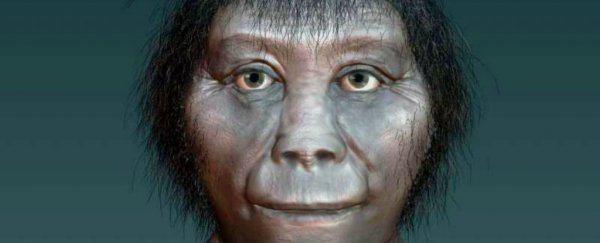Once upon a time, on an island in Indonesia, there lived a hobbit.
If you're familiar with the ongoing adventures of the species of human 'hobbit', Homo floresiensis, you might be interested in the latest exciting chapter – new research suggests the tiny, ancient hominids were closely related to a human ancestor that lived in Africa a couple million years ago, and not H. erectus, as had been widely assumed.
A team of researchers from the Australian National University took a close look at over 100 bone characteristics from 11 species of human relative, including Australopithecus afarensis, H. erectus, H. habilis, and H. sapiens.
By applying statistical tools (and a good dose of Occam's Razor) they concluded that there is no evidence supporting the current leading hypothesis on H. floresiensis's origins.
To quickly recap, in 2003 a joint Australian and Indonesian expedition investigating the migration of humans from Asia to Australia stumbled across the remains of a hominid in a cave on the Indonesian island of Flores.
The nearly complete skeleton belonged to an adult female who stood about one metre (3.3 feet) high and had a brain roughly the size of a grapefruit, suggesting she probably weighed a petite 25 kilograms (55 pounds).
Since then other bones have been found, ranging in age from 60,000 to 100,000 years old, with nearby stone tools dating back as far as 190,000 years until as recently as about 50,000 years ago.
Over the years, researchers have pieced together a number of hypotheses to explain the story of what affectionately became known as the 'hobbit'.
In one scenario, the initial remains were considered to be from an anatomically modern human who suffered from some sort of condition, such as microcephaly, hypothyroidism, or Down syndrome.
Over the years studies have ruled out pathology as an explanation for the fossil's unusual size, leaving us to attempt to figure out how this distinct species of human relative fits into our family tree.
The running favourite hypothesis is a nearby population of H. erectus made the crossing to Flores around 840,000 years ago and stayed put.
Historically known as Java man due to the initial discovery of its remains on the Indonesian island, H. erectus certainly lived in the area between 1.6 million and 100,000 years ago, and based on evidence of stone tools visited the island at least once.
Since Flores has always had a couple dozen kilometres (around 15 miles) of water separating it from the nearest island, mixing of genes with other nearby groups of H. erectus would have been uncommon, leading them to diverge into a form of island or 'insular' dwarfism.
While conveniently local, there's been little evidence one way or another to confirm or refute the relationship. Until now.
"We found that if you try and link them on the family tree, you get a very unsupported result. All the tests say it doesn't fit – it's just not a viable theory," said researcher Debbie Argue of the ANU School of Archaeology & Anthropology.
On analysing the remains of H. floriensis, the researchers decided that structures such as the shape of the jaw were too primitive to have come from H. erectus.
"Logically, it would be hard to understand how you could have that regression – why would the jaw of Homo erectus evolve back to the primitive condition we see in Homo floresiensis?" said Argue.
So if the evidence shows our intrepid hobbit cousin probably didn't split from a nearby population of H. erectus or H. sapiens, where did it come from?
The primitive characteristics point at a rather early separation from a more ancient species of hominid more than 1.75 million years ago, most likely an ancestor closely related to a hominid living in Eastern and Southern Africa between 2.4 and 1.4 million years ago called Homo habilis.
"The analyses show that on the family tree, Homo floresiensis was likely a sister species of Homo habilis. It means these two shared a common ancestor," Argue said.
What this means is a diminutive population of ancient humans more closely related to H. habilis than any other human species set off from Africa a few million years ago, wandered through Asia, before finding themselves in far corners of the world like Flores.
Presumably no wizards were involved in their decision to set off for far off lands.
Like all other species of human-like animals, the hobbit faded from history, leaving behind a scattering of bones on an island and a few chipped stones to provide hints of their story.
Future discoveries and analyses of hominid fossils could provide more details on the exact nature of this branching, and whether the hobbit truly is a sister species to H. habilis or even belongs to the group that gave rise to H. erectus and modern humans.
This latest twist in the hobbit's ongoing saga shows for all we've accomplished as humans, we're still just one branch in a magnificent bush of hominids.
This research was published in the Journal of Human Evolution.
